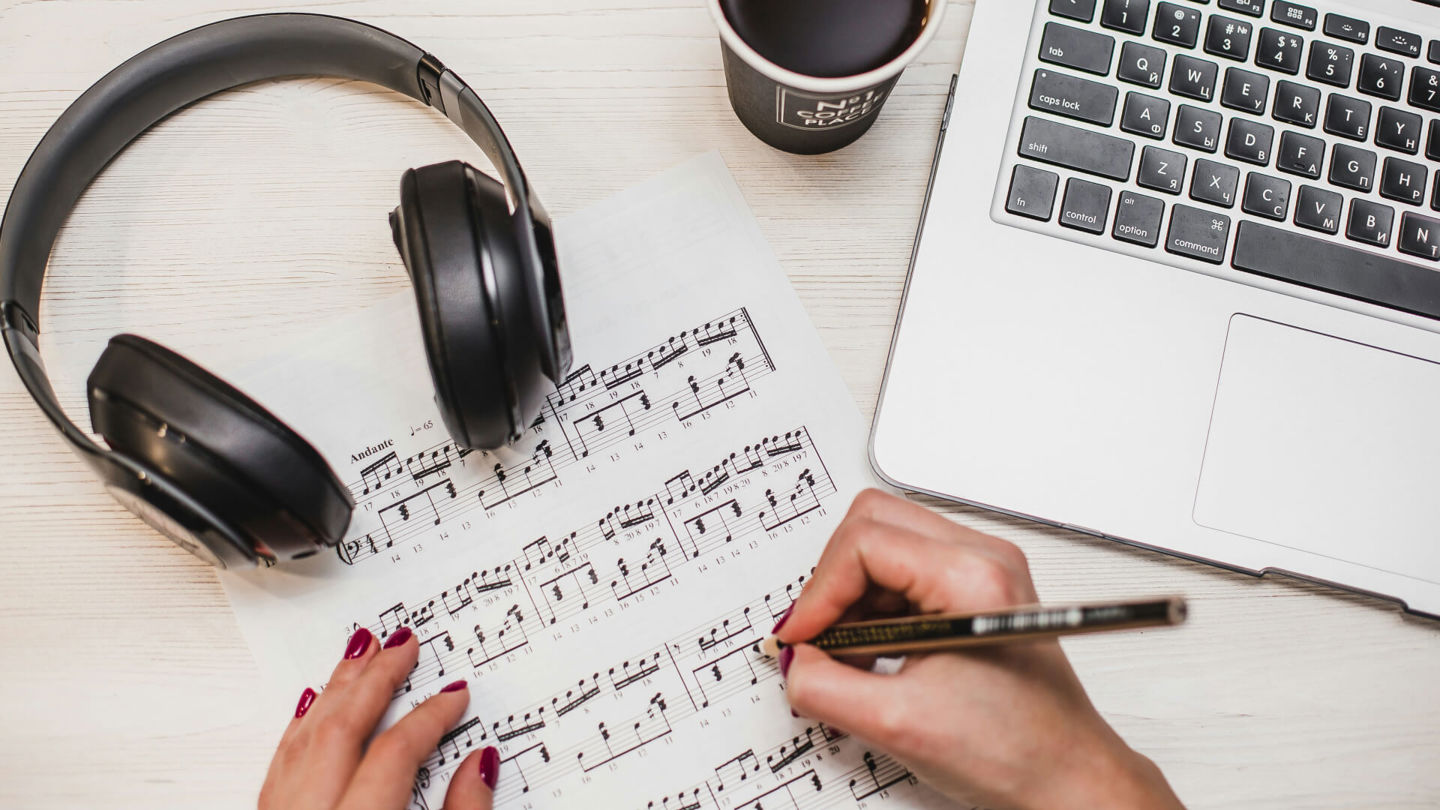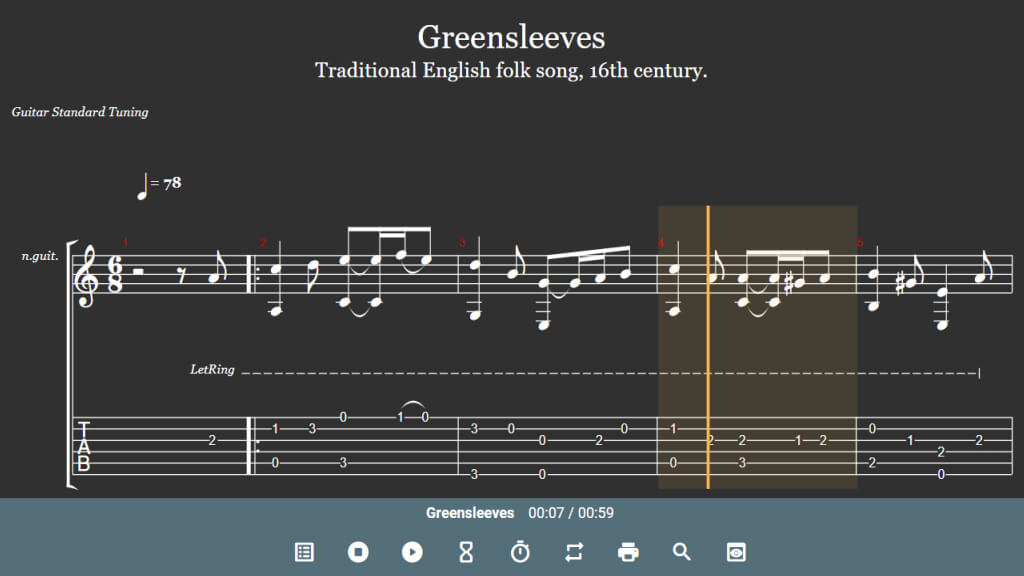In today’s fast-paced world of music technology, everything seems easier than ever: learning to play guitar is just a click away. You can watch video lessons, download tabs, use chord analysis apps, and even ask AI to write a song for you. These tools truly help beginners start their musical journey without digging into dry theory books.
But behind this seeming simplicity lies an essential truth: music literacy — especially the ability to read standard notation — remains a vital skill for any serious musician.
Music notation isn’t just about reading dots and stems on a page. It’s a way of thinking in sound, a method to understand music not just by ear, but also visually and structurally. It’s like learning a language: you can memorize a few phrases and get by, but only by knowing the grammar can you truly express your thoughts, understand others, and grow.
For guitarists — especially fingerstyle players — it might seem like intuition, tabs, and a good ear are enough. But the moment you start working with other musicians, want to write down your own compositions, analyze the works of great masters, or go beyond your usual style, notation opens up a world that tabs alone can’t reach.
In this article, we’ll explore why standard notation remains relevant even in the digital age, how it benefits guitarists, and how understanding it transforms your approach to music.
1. Music Notation Is the Language of Music
Imagine being in a room with musicians from different countries. One plays violin, another saxophone, another piano. Each has their own style, habits, and technique. But once someone pulls out sheet music, suddenly everyone understands each other. That’s the magic of notation — a universal language that connects musicians across instruments and cultures.
Tabs are great when you’re learning a specific song on your own. They tell you where to place your fingers and which strings to play. But:
- They don’t show rhythm — you still have to guess or listen to the original.
- They’re instrument-specific — guitar tabs are meaningless to a flutist or pianist.
- They lack a big-picture view — no harmonies, no modulations, no key changes — just fret numbers.
Notation, on the other hand, reveals the full structure of the music. You see how the melody flows, how notes relate in pitch and time. This allows you to:
- Arrange music — know how to assign parts across instruments.
- Play in an ensemble — read from a full score and stay in sync.
- Write original compositions — that others can read and perform.
- Communicate professionally — with musicians, teachers, producers, or sheet music editors.
Knowing how to read music is like speaking the language fluently: you stop being a tourist and become a true citizen of the musical world. You don’t just play what you hear — you understand what you’re playing, and why it sounds the way it does.

Photo by Oswaldo Claro on Unsplash
2. Deeper Musical Understanding and Faster Learning
Knowing how to read music transforms the way you perceive it. You start to notice patterns, recognize familiar motifs, anticipate harmonies, and understand structure. This isn’t dry theory — it’s a practical tool that speeds up your learning process and makes it more intentional.
Here are a few real-world examples of how this works:
- Faster learning of new pieces — when you can read sheet music, there’s no need to replay the track dozens of times to figure out the rhythm or dynamics. You immediately see where the climax is, where the rests are, and how each phrase leads to the next.
- Analyzing other people’s music — instead of memorizing chords blindly, you can see how transitions are built, what scale is used, and where the modulations happen. It’s not just copying — it’s learning through understanding.
- Better memory retention — it might sound counterintuitive, but notation actually helps you remember music more quickly. When you grasp the logical structure, it sticks in your mind more reliably than memorizing by ear.
- Arranging and improvising — the ability to read and understand music gives you a powerful creative tool. You can draw from other genres, reinterpret harmonies, vary melodies — all without fear of messing things up, because you know how it all fits together.
This is especially relevant for fingerstyle guitarists, where melody, accompaniment, and rhythm are tightly interwoven. Many fingerstyle pieces demand precise control of sound — from the bass line to subtle notes in the upper register. When you can read notation, you immediately see where everything sits, how the voices relate, and how to bring out the right expression.
As a result, learning becomes not only faster but far more engaging. You’re no longer just memorizing what to play and how — you start thinking like a composer, like a true musician who understands the purpose behind every note.
3. The Ability to Capture and Share Your Musical Ideas
Every guitarist has been there: a beautiful melody, an inspiring riff, or a unique harmony suddenly comes to mind. You play it a few times, thrilled by the discovery — and then... the next day, it’s completely gone. Writing it down in tablature can be a hassle, especially if your idea includes complex rhythms or multiple voices. And sure, you could record an audio clip — but what if you want to share your idea with other musicians, not just replay it by ear?
That’s where music notation becomes your true ally. The ability to write down your music with precise rhythm, timing, and dynamics is a superpower for the modern musician. And this isn’t just for classical or academic composers. Whether you play original instrumental pieces, fingerstyle, blues, or jazz, being able to score your music offers huge benefits:
- Preserve your ideas — you can always come back to them and recreate them exactly as you envisioned.
- Open the door to publishing — share your scores on platforms like Musescore or Flat.io, or even monetize your sheet music.
- Simplify collaboration — if you’re in a duo or a band, just print out the score, hand it to your partners, and start rehearsing from the very first second.
- Create your own arrangements — rewrite well-known pieces to fit your personal style, with your preferred voices, rhythms, and dynamics.
Notation gives you a sense of control: you’re no longer at the mercy of your memory or chance. You’re capturing your music like a painter captures a scene. It transforms you from a player into a true author and storyteller — except your words are written in notes.
4. Broadening Your Musical Horizons and Stylistic Versatility
Today’s guitarist rarely sticks to just one genre. One day you’re playing the blues, the next it’s a fingerstyle cover of a pop hit, and by the weekend you’re experimenting with jazz harmonies. This is exactly where music notation becomes not just helpful, but essential for mastering new styles.
Music literacy empowers you to:
- Read and analyze works from different eras and genres — from Bach’s baroque masterpieces to jazz standards.
- Study original scores by great composers — and see how they approached expression, form, and harmony.
- Understand less familiar forms of notation — such as classical etudes or concert pieces that aren’t adapted into tabs.
- Learn from other instruments — by studying piano scores, borrowing phrases from wind, string, or vocal parts, and adapting them for guitar.
In this way, music notation becomes a key to the vast library of world music. Many brilliant pieces aren’t available in tablature — and when they are, they’re often simplified or inaccurate. Being able to read the original sheet music gives you direct access to the composer’s true intention.
Working with notation also helps develop musical thinking. You start to notice:
- Repetitions, variations, and symmetrical forms.
- Modulations and key changes.
- Unique melodic ideas you can borrow and use in your own music.
You begin to think not just as a performer, but also as an arranger, composer, and explorer — and that’s especially important for anyone who wants to grow not only in breadth, but in depth as a musician.

Photo by Veronika Tarakanova on Unsplash
5. Boosting Professionalism and Career Opportunities
If you’re seriously considering turning music into a profession — whether it’s teaching, performing, studio work, or composing — knowing how to read music becomes a real competitive advantage.
Here’s why:
- Professional studios, orchestras, and ensembles often rely on sheet music — you may be asked to sight-read, adapt material, or blend with other musicians. Without reading notation, that’s nearly impossible.
- Teaching music involves more than just playing — you need to explain rhythm, melody, and structure. How can you teach what a syncopation or triplet is if you don’t understand how they’re written?
- Session work with artists or producers — often requires reading or editing scores, especially for live shows, theater productions, or radio and TV performances.
- Original arrangements or scores submitted to publishers, contests, or grant programs are expected in written form — even if you’re a brilliant guitarist, you won’t be heard without a proper score.
In a world where thousands of guitarists are vying for attention, the ability to read and write music sets you apart as a serious and well-rounded musician. It acts as a seal of quality: you’re not just playing — you’re thinking in musical terms, like a professional.
And even if a music career isn’t your goal, music literacy gives you confidence and a strong foundation. It broadens your perspective and opens doors you might not even know exist.
Conclusion
The world of music has never been more accessible. Today, you can learn a song just by watching a video tutorial. You can find a tab for almost any piece, and use apps that show you where to place your fingers and in what order to pluck the strings. These are incredible tools — and they truly work.
But real depth, freedom, and awareness come when you start to see music, not just hear it. Music notation is not a limitation or a relic of the past. It’s a tool that opens up the full musical universe. It doesn’t replace intuition or inspiration — it helps you focus them. It doesn’t take the soul out of music — it helps you express it more clearly.
When you understand notation, you’re no longer just a performer — you develop musical thinking. It helps you learn faster, compose, share ideas with others, play in an ensemble, analyze, and improvise. Ultimately, you begin to experience music not as a collection of sounds, but as a living, logical, and beautiful system — a language you can speak fluently.
This deeper understanding doesn’t just make you more confident in rehearsals or when composing — it also transforms how you feel on stage. If you’re looking to prepare for performances and manage stage anxiety, check out the article “Secrets to a Successful Live Performance”. And if you’re wondering whether technology can replace talent, our piece “Guitar Trends: Will Artificial Intelligence Start Writing Music for Us?” dives into that topic from multiple angles.
Believe in your growth. Reading music isn’t a test — it’s a journey. It begins with your first simple melody and may lead you to a concert stage, your own album, or just that powerful moment when you smile and think, “Yes, now I truly understand music”. And that feeling is worth every step.














